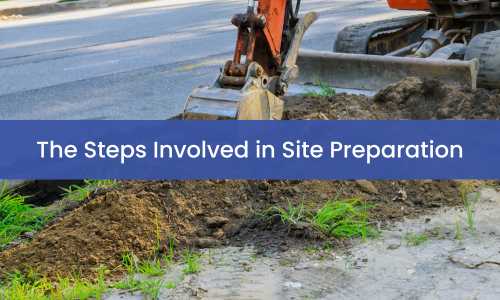Site preparation is a set of pre-construction processes needed to develop a site for a building project. The steps involved in site preparation include:
- Soil testing
- Site survey
- Site planning
- Site clearing and demolition
- Site access
- Site excavation
- Drainage structure installation
- Site grading
It takes a variety of skills and equipment to prepare a site for commercial construction, so property owners typically turn to site development experts to prepare their site.
Here is a closer look at the site preparation process and what a reputable contractor will do to prepare a site for construction:
1) Soil Testing
During soil testing, the development team will verify that the site’s soils are ready for construction. This involves sampling the site and sending the sample for lab analysis – typically by an engineer.
Soil testing provides information about the following:
- The type of soil – Sand, silt, clay, gravel, and loam (a mixture of sand, silt and clay) all have different water absorption, drying, and movement characteristics.
- The soil’s load bearing capabilities – The soil’s composition will dictate whether it can take a foundation, and what type of foundation it can handle.
- Drainage needs – Soils that absorb and hold onto water (high-clay soils) require additional drainage considerations prior to construction.
2) Site Surveying
During site surveying your site developer will walk the property and place markings in the ground to point out property lines, utility lines, and any underground hazards, such as debris.
This step verifies the building location and confirms that the general construction plan is feasible. It also gives the developer an idea of how to set up the property’s drainage.
3) Site Planning
During site planning, the development crew will create the project’s master plan. This includes identifying building areas, elevations, trees, drainage structures, utility lines, property lines, roads, and other important features.
Your site plan drawings will be used to acquire building permits. It’s standard practice for property owners to bring in an engineer for this step, given the plan’s importance and role as the master reference document.
4) Site Clearing and Demolition: Removing Vegetation and Previous Construction
During demolition and site clearing, the site developer will remove vegetation, remnants of previous construction, and other obstacles. This may include grubbing (removing tree and vegetation roots) and high-risk demolition work.
Not all site developers are equipped for demolition tasks. In addition to excavators and bulldozers, demolition teams may require grapplers, shears, pulverizers, and trucks for material removal. Demolition crews also require additional safety training and technology to do their job safely.
6) Site Excavation
During excavation, soil is removed from the site to make way for building foundations, drainage structures and any landscaping features.
Excavation may include significant earthworks and trenching, which involves cutting narrow grooves into the soil for wall shafts, utility lines and drainage lines. Excavation may also be necessary when removing damaged pavement. In each case, there will be material to haul off, though some of the excavated material may be repurposed elsewhere on the site during grading.
7) Drainage Structure Installation
Efficient drainage protects your property from flooding and your buildings from water damage. Without proper drainage measures in place, water will pool around foundations following every bout of wet weather, causing early failure and necessitating expensive repairs.
Site developers lay the groundwork for any drainage structures before construction. This includes installing retention or detention ponds, excavating drainage trenches, installing catch basins and gutter systems, and sloping the site. Site developers who also have concrete experience can install these drainage structures once excavation is complete.
8) Site Grading
Grading is one of the last steps during site development and involves shaping and leveling the site. It’s during this phase that retention walls and other landscaping features are carved out of the earth. Grading also promotes better drainage and is necessary to create level build pads for structures.
At the end of the grading process, the site developer will lay down a layer of topsoil for any planting areas.
Choose a Pavement Contractor that Handles Site Preparation and More
Following site preparation, your property will be shaped and sloped to fit your construction project.
The likely next step is laying down foundations or other pavement work. For this step, you’ll need an expert pavement contractor to handle the job.
Some site preparation crews are also experienced in concrete and asphalt work, and it can be beneficial to choose a reputable company that can do both. You’ll only have one point team to communicate with, and it will be easier to remain on time and on budget.
- HOA & Condos – How Asphalt Pavement Can Affect Your Houston Property Values - March 6, 2025
- What Certifications or Licenses Should a Houston Asphalt Contractor Have? - September 17, 2024
- Common Challenges in Concrete Construction - September 11, 2024

